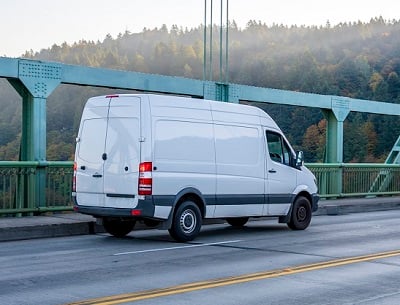As people across the globe were confined to their homes and regions by COVID-19, e-commerce experienced a sharp growth spike. This is set to continue throughout 2021 and beyond, with research showing that 2.14 billion people worldwide will continue to purchase goods and services online, breaking historical records [1].
 The knock-on effect this buying behaviour has had on the commercial fleet sector has been significant. Throughout the pandemic, for example, the road freight medium-duty vehicle segment has proven far more resilient than its heavy-duty equivalent, which faced long-haul and cross-border transport disruption. As a result, the medium-duty vehicle is fast becoming the chosen class for many road freight businesses.
The knock-on effect this buying behaviour has had on the commercial fleet sector has been significant. Throughout the pandemic, for example, the road freight medium-duty vehicle segment has proven far more resilient than its heavy-duty equivalent, which faced long-haul and cross-border transport disruption. As a result, the medium-duty vehicle is fast becoming the chosen class for many road freight businesses.
Optimising on-road opportunities with the medium-duty segment
A prime example of this shift in vehicle class is the growth of last-mile delivery – the transport of goods from the hub to the final destination – which is set to expand by 78% before 2030 [2]. Although this is just one area where medium-duty opportunities are arising, with the segment increasingly filling roles once dominated by heavy-duty equivalents but left exposed by COVID-19.
In 2020 for example, there was an uptick in lighter vehicles (six to nine tons) carrying out long-distance transport tasks, allowing organisations to continue operating during the pandemic in an efficient and compliant way [3].
Notably, vehicles in the medium-duty segment also offer substantial savings opportunities – as for non-oversized loads they are a cost effective purchase compared to heavy-duty trucks and their operating and maintenance costs are also less by comparison. In addition to this, medium-duty compliance costs and road tax are also lesser compared to heavy-duty trucks as in most countries they are taxed based on their engine size/ axle capacity.
With the spotlight now on the medium-duty segment, fleet operators cannot afford to allow inefficiencies to prevent them from seizing these emerging opportunities. However, in spite of this urgency, a concerning number of fleet operators are still struggling to improve their operations:
“More than half of fleet operators (52%) find it challenging to increase operating efficiency.”[4]
While COVID-19 has played an important role in raising the profile of the medium-duty segment, it goes without saying that the pandemic has also increased industry cost pressures, tightened margins and further highlighted the need for more sustainable solutions. Fleet operators must therefore identify ways to increase outputs while using fewer resources, so as to bolster the bottom line while taking action on sustainability targets. To rise to this challenge, operators must ensure they are optimising the variables they have control of, particularly in terms of consumables.
 Keep fuel top of mind to protect the bottom line
Keep fuel top of mind to protect the bottom line
Making the wrong fuel choice accounts for 45% of unplanned vehicle downtime among commercial road transport companies according to Shell research, representing massive inefficiency and lost value for fleets [4]. Because of the huge impact fuel choice has on vehicle performance and business bottom lines, it should be a primary consideration for fleet operators who need to improve their medium-duty operations.
Selecting the right fuel is not only essential at the outset to prevent significant unplanned downtime, but also in terms of limiting overall fuel consumption and reducing emissions. And since medium-duty fleets most likely operate in urban areas under variable speeds, it is even more important to consider how fuel usage can be made more efficient to limit emissions output. Injector system cleanliness serves as a prime example.
Shell FuelSave Diesel has been designed to remove built-up carbon deposits from fuel injectors and increase fuel economy by up to 2.9% . Cleaner injectors subsequently reduce carbon emissions and black smoke causing a double action of improving operational efficiency and sustainability. The formulation has also been proven to generate an average of 6% more acceleration in comparison to regular diesel, providing enhanced performance while maintaining engine efficiency [5].
While two-thirds of transport companies believe investing heavily in new equipment and vehicle types increases profitability [4]; choosing the right fuel and managing it correctly holds the key statistically – with the savings from putting the right fuel strategy in place can be as high as 30% [6].
Above all, identifying and selecting the right fuel is critical because it represents approximately 23% of fleet operating costs on average [4]. Because of the size of this cost area, it is vital that medium-duty fleet operators ensure they are getting the most benefit from their fuel spend.
Technologies that can help shift your efficiency up a gear
During the COIVD-19 pandemic, fleet operations were put under immense pressure. Logistical challenges, fluctuating amounts of goods, and the complexities of navigating local and national restrictions forced businesses to optimise their operations or risk going under. Many fast tracked digitalisation to help improve efficiency and protect their business in an environment that required them to be agile and highly reactive.
The transport industry is also suffering from widespread load inefficiency, with 12.3% of road freight journeys in Europe performed by empty vehicles in 2018 [7]. As per Frost & Sullivan’s research and analysis, the inefficiency gap is expected to further increase beyond 2021, attributable to freight matching technologies not keeping pace with growth in transportation and logistics.This can have a huge impact on costs due to poorly optimised fuel usage and unwanted strain on critical parts, while also adding unnecessary fleet emissions.
 Fortunately, AI-driven, innovative digital freight brokering technologies have the capability to boost transport efficiencies and reduce empty miles by 10%, as well as increase load efficiency by 11% [8]. In addition, route optimisation and delivery scheduling technologies offer opportunities to plug scheduling gaps and get more out of critical consumables like fuel.
Fortunately, AI-driven, innovative digital freight brokering technologies have the capability to boost transport efficiencies and reduce empty miles by 10%, as well as increase load efficiency by 11% [8]. In addition, route optimisation and delivery scheduling technologies offer opportunities to plug scheduling gaps and get more out of critical consumables like fuel.
Shell Telematics, for example, equips fleet operators with the data they need to optimise operations, helping them monitor all vehicle and Shell Card data through one platform and cut down on administration time and costs through seamless integration. Leveraging data collected by connected sensors on the vehicle, Shell Telematics can also help to identify developing problems before they cause downtime.
With maintenance representing 20 – 30% of a commercial vehicle’s lifetime cost – and unplanned maintenance imposing even higher prices – it is little surprise that 71% of respondents in Frost & Sullivan’s Fleet Manager Survey indicated that they would be interested in remote diagnostics or prognostics data being integrated into their organisation’s management system [8].
The same research also points to video safety systems – projected to drive a 17.8% market growth rate in 2021 – as another example of how telematics can benefit fleets through the generation of actionable insights.
Frost & Sullivan’s Vice President- Mobility Research Mr. Sathyanarayana Kabirdas has the following to say on the topic: “It’s been a turbulent period for many industries, but as the commercial fleet sector has proven, with challenge comes opportunity. Whether it’s the growth of last mile delivery or e-commerce, fleets must be quick to adapt to changing consumer behaviours by integrating effective digital solutions and making the correct consumable decisions.”
Technology and fuel: A winning formula
Ultimately, medium-duty fleet operators are faced with a challenging environment. But they are also presented with a unique and growing set of opportunities. Unlocking these opportunities and staying competitive will require: optimisation of loads; maximised scheduling; sustainability consciousness; and an understanding of the factors that dictate last-mile delivery success. And underpinning the effectiveness of all of these steps is the selection of the right consumables, to ensure efficiency is maintained no matter the conditions.
Authors: Sven Thiede, Vice President Mobility at Frost & Sullivan, and Elitza Terzova, Global Fuels Product Manager at Shell Commercial Fuels
For more information, you can:
- Visit the Shell website: shell.com/commercialfuels
- Explore Shell FuelSave Diesel and Shell Diesel Extra: https://www.shell.com/business-customers/commercial-fuels/shellfuelsavediesel.html
- Contact a local Shell representative: https://www.shell.com/business-customers/commercial-fuels/contact-commercial-fuels.html
- Visit the Frost & Sullivan Mobility Practice website: https://ww2.frost.com/research/industry/mobility-automotive-transportation/
[1] Statista, https://www.statista.com/statistics/251666/number-of-digital-buyers-worldwide/ (accessed March 2021).
[2] World Economic Forum, ‘Online shopping is polluting the planet – but it’s not too late’, 2020: https://www.weforum.org/agenda/2020/01/carbon-emissions-online-shopping-solutions/ (accessed March 2021).
[3] Frost & Sullivan,”Global Light, and Medium and Heavy Commercial Vehicle Outlook”, 2021.
[4] This survey commissioned by Shell Commercial Fuels and conducted by independent research firm Edelman Intelligence, polled 400 fuel decision-makers in the transport sector in eight countries (Canada, Germany, Malaysia, Philippines, Singapore, South Africa, Thailand, Turkey).
[5] Based on a demonstration test run with a medium-duty truck in real-world conditions and endorsed by renowned independent laboratory UTAC CERAM Millbrook. Fuel economy was improved under all measured conditions by 1.7% average and up to 2.9% under selected test conditions.
[6] Case study: Mayang Bayumas Sdn Bhd’s upgrade to the New Shell FuelSave Diesel saw the reduction of unplanned vehicle breakdowns from an average of five per month to only one in three months.
[7] Eurostat Statistics, ‘Road freight transport by journey characteristics’, https://ec.europa.eu/eurostat/statistics-explained/index.php?title=Road_freight_transport_by_journey_characteristics (accessed May 2021).
[8] Frost & Sullivan, “Fleet Managers’ Desirability and Willingness to Pay for Advanced Truck Technologies”, 2021.

















